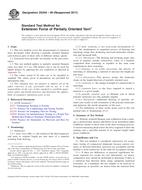We need your consent to use the individual data so that you can see information about your interests, among other things. Click "OK" to give your consent.
ASTM D5344-99(2011)
Standard Test Method for Extension Force of Partially Oriented Yarn
STANDARD published on 1.12.2011
The information about the standard:
Designation standards: ASTM D5344-99(2011)
Note: WITHDRAWN
Publication date standards: 1.12.2011
SKU: NS-30811
The number of pages: 6
Approximate weight : 18 g (0.04 lbs)
Country: American technical standard
Category: Technical standards ASTM
The category - similar standards:
Annotation of standard text ASTM D5344-99(2011) :
Keywords:
force, extension, partially-oriented, yarn , Extension force, Filament yarn, Partially oriented yarn, Yarns, ICS Number Code 59.080.20 (Yarns)
Additional information
| Significance and Use | ||||||||||
|
This test method is considered satisfactory for acceptance testing of commercial shipments because current estimates of between-laboratory precision are acceptable and the method is used extensively in the trade for acceptance testing. If there are differences or practical significance between reported test results for two laboratories (or more), comparative tests should be performed to determine if there is a statistical bias between them, using competent statistical assistance. As a minimum, the test samples to be used are as homogeneous as possible, are drawn from the material from which the disparate test results are obtained, and are assigned randomly in equal numbers to each laboratory for testing. Other materials with established test values may be used for this purpose. The test results from the two laboratories should be compared using a statistical test for unpaired data, at a probability level chosen prior to the testing series. If a bias is found, either its cause must be found and corrected, or future test results must be adjusted in consideration of the known bias. Elapsed time between spinning and testing has a marked effect on the results of the draw tension test, especially during the first 24 h. Therefore, if tested within 24 h of spinning, specimens should be compared only if tested after the same elapsed time. No specimen should be tested within 4 h of spinning because the aging process is at its most rapid rate during this period, and the differences in rate due to fiber structure are most pronounced. The extension force of manufactured filament yarns is related to the alignment of the molecules in the yarn filaments, which influences the yarn processing behavior. Knowledge of this property of partially oriented yarn is useful to determine processing conditions. |
||||||||||
| 1. Scope | ||||||||||
|
1.1 This test method covers the measurement of extension force developed while drawing a partially oriented filament yarn between pairs of draw rolls of different surface speeds. 1.2 Extension force provides an estimate of the yarn orientation. 1.3 This test method applies to partially oriented filament yarns less than 33.3 tex (300 denier), but it can be used for higher deniers by applying the test conditions as directed in Appendix X1. 1.4 The values stated in SI units are to be regarded as standard. The values given in parentheses are provided for information only. 1.5 This standard does not purport to address all of the safety concerns, if any, associated with its use. It is the responsibility of the user of this standard to establish appropriate safety and health practices and determine the applicability of regulatory limitations prior to use. |
||||||||||
| 2. Referenced Documents | ||||||||||
|
Similar standards:
Historical
1.12.2011
Historical
1.7.2013
Historical
1.7.2008
Historical
1.7.2012
Historical
1.6.2010
Historical
1.7.2013
We recommend:
Technical standards updating
Do you want to make sure you use only the valid technical standards?
We can offer you a solution which will provide you a monthly overview concerning the updating of standards which you use.
Would you like to know more? Look at this page.



 ASTM D1244-98(2011)..
ASTM D1244-98(2011).. ASTM D1422/D1422M-13..
ASTM D1422/D1422M-13.. ASTM D1423-02(2008)..
ASTM D1423-02(2008).. ASTM D1907/D1907M-12..
ASTM D1907/D1907M-12.. ASTM D204-02(2010)e1..
ASTM D204-02(2010)e1.. ASTM D2255/D2255M-09..
ASTM D2255/D2255M-09..
 Cookies
Cookies
